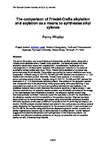The comparison of Friedel-Crafts alkylation and acylation as a means to synthesise alkyl xylenes
| dc.contributor.author | Whalley, P. | |
| dc.date.accessioned | 2019-05-20T09:46:55Z | |
| dc.date.available | 2019-05-20T09:46:55Z | |
| dc.date.issued | 2016 | |
| dc.identifier.citation |
Whalley, P. (2016) 'The comparison of Friedel-Crafts alkylation and acylation as a means to synthesise alkyl xylenes', The Plymouth Student Scientist, 9(1), p. 252-296. | en_US |
| dc.identifier.issn | 1754-2383 | |
| dc.identifier.uri | http://hdl.handle.net/10026.1/14124 | |
| dc.description.abstract |
The aim of this project was to synthesise and characterise an alkyl xylene using both a Friedel-Crafts alkylation and a Friedel-Crafts acylation. The literature stated that whilst alkylation raised many issues with polyalkylation, transalkylation, dealkylation and rearrangement of the electrophile, acylation with subsequent reduction of the carbonyl provided a far less problematic route. Firstly, Friedel-Crafts alkylation of m-xylene was performed using t-butyl chloride. The product was purified by vacuum distillation and rotary evaporation. Analysis using IR, GC-FID, GC-MS and NMR allowed the conclusion of a 1,3,5-trisubstituted benzene product. Secondly, Friedel-Crafts acylation of m-xylene was performed using butyryl chloride. Analysis using IR, GC-FID, GC-MS and NMR allowed the conclusion of a 1,2,4-trisubstituted benzene product. The product of the alkylation reaction was unexpected due to the pre-existing methyl groups being ortho-para-directing. It was concluded that attack at the ortho and para positions allowed the intermediates to be stabilised, however due to steric hindrance the products would be of higher energy. It was therefore deemed that the acylation reaction product was kinetically controlled as the energy of the intermediates most influenced it; however, the alkylation reaction product was thermodynamically controlled. Literature stated this was likely to do with the reversibility of the alkylation reaction and the irreversibility of the acylation reaction. Grignard reactions were carried out on the synthesised acyl xylene using ethyl bromide and propyl bromide. With both reactions, a new peak at 3500 cm-1 occurred on the IR confirming synthesis of an alcohol. GC-MS analysis showed residual acyl xylene in the crude product as well as several peaks displaying the fragmentation patterns for the expected product. It was concluded that the GC-MS for the reaction using ethyl bromide displayed a greater number of peaks with similar fragmentation patterns due to the introduction of a chiral carbon. Further research suggested included the dehydration and hydrogenation of the Grignard products, the acylation and alkylation reactions carried out at varying temperatures and the acylation carried out with a branched acyl chloride. | en_US |
| dc.language.iso | en | en_US |
| dc.publisher | University of Plymouth | |
| dc.rights | Attribution 3.0 United States | * |
| dc.rights.uri | http://creativecommons.org/licenses/by/3.0/us/ | * |
| dc.subject | alkyl xylene | en_US |
| dc.subject | synthesise | en_US |
| dc.subject | Friedel-Crafts alkylation | en_US |
| dc.subject | Friedel-Crafts acylation | en_US |
| dc.subject | polyalkylation | en_US |
| dc.subject | transalkylation | en_US |
| dc.subject | dealkylation | en_US |
| dc.subject | rearrangement of the electrophile | en_US |
| dc.subject | GC-MS analysis | en_US |
| dc.subject | GC-FID | en_US |
| dc.subject | IR | en_US |
| dc.title | The comparison of Friedel-Crafts alkylation and acylation as a means to synthesise alkyl xylenes | en_US |
| dc.type | Article | |
| plymouth.issue | 1 | |
| plymouth.volume | 9 | |
| plymouth.journal | The Plymouth Student Scientist |



